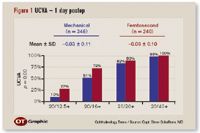Article
Flap creation can affect visual acuity, recovery
Author(s):
London-In a comparison of visual outcomes with the femtosecond laser and mechanical microkeratomes following LASIK, both were very effective at targeting emmetropia. Eyes treated with the femtosecond laser, however, had faster visual recovery and better uncorrected visual acuity (UCVA) results at 3 months despite experiencing more transient symptoms immediately after surgery, reported Capt. Steve Schallhorn, MD, here at the XXIV Congress of the European Society of Cataract and Refractive Surgeons.

"One of the primary advantages of LASIK over a surface procedure is faster visual recovery," Dr. Schallhorn said. "We found the recovery after LASIK was even faster when the femtosecond laser was used to create the flap instead of a bladed keratome. Equally or more significant, the quality of vision as measured by contrast acuity was better through 3 months follow-up."
Dr. Schallhorn and Dave Tanzer, MD, conducted the study using the VISX Star S4 CustomVue (Advanced Medical Optics [AMO]) and two flap techniques. Both doctors performed surgeries with two mechanical microkeratomes (Hansatome, Bausch & Lomb; Amadeus, AMO) and a 15-kHz femtosecond laser (IntraLase, IntraLase Corp.).
Because no difference in outcomes was found between the immediate and staged groups, Dr. Schallhorn and Dr. Tanzer combined the results when conducting their analysis of endpoints such as flap characteristics and refractive and visual outcomes.
The doctors treated 220 patients (436 eyes) with the mechanical keratomes and 150 patients (300 eyes) with the femtosecond laser. The groups were well matched in sphere, cylinder, and manifest spherical equivalent (MSE) characteristics.

Despite the transient symptoms among those in the femtosecond laser patient group, these eyes had better UCVA on the first day postoperatively.
"UCVA results were surprisingly and significantly better with the femtosecond laser than the mechanical keratomes," Dr. Schallhorn said, although he added that the results with the mechanical keratomes also were very good.
UCVA results
On the first day, 20/16 UCVA was achieved in 72% of patients treated with the femtosecond laser and 51% of patients treated with a mechanical keratome; 20/12.5 UCVA was achieved in 27% and 10%, respectively. The mean UCVA LogMar ± SD rates were –0.03 ± 0.11 for the mechanical keratome-treated eyes and –0.08 ± 0.10 D for the femtosecond-treated eyes (p = 0.00).
At 3 months, the mechanical keratome group had considerable improvement in UCVA, but differences between the two groups were still significant, Dr. Schallhorn said. Forty-three percent of the femtosecond laser-treated eyes had 20/12.5 UCVA or better, compared with 29% of the mechanical keratome-treated eyes.
"That's a phenomenal result," Dr. Schallhorn said. "The mechanical results were good, but the femtosecond results were even better."
Newsletter
Don’t miss out—get Ophthalmology Times updates on the latest clinical advancements and expert interviews, straight to your inbox.




